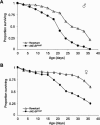Starvation and oxidative stress resistance in Drosophila are mediated through the eIF4E-binding protein, d4E-BP
- PMID: 16055649
- PMCID: PMC1186182
- DOI: 10.1101/gad.1311805
Starvation and oxidative stress resistance in Drosophila are mediated through the eIF4E-binding protein, d4E-BP
Abstract
eIF4E, the mRNA 5' cap-binding protein, is regulated by its binding protein (4E-BP), a downstream target of phosphatidylinositol-3-OH kinase [PI(3)K] signaling. We show that Drosophila 4E-BP (d4E-BP) activity becomes critical for survival under dietary restriction and oxidative stress, and is linked to life span. The Drosophila forkhead transcription factor (dFOXO) activates d4E-BP transcription. We show that ectopic expression of d4E-BP in dFOXO-null flies restores oxidative stress resistance to control levels. Thus, d4E-BP is an important downstream effector of a dFOXO phenotype, and regulation of translation by eIF4E is vital during environmental stress.
Figures





References
-
- Avdulov S., Li, S., Michalek, V., Burrichter, D., Peterson, M., Perlman, D.M., Manivel, J.C., Sonenberg, N., Yee, D., Bitterman, P.B., et al. 2004. Activation of translation complex eIF4F is essential for the genesis and maintenance of the malignant phenotype in human mammary epithelial cells. Cancer Cell 5: 553–563. - PubMed
-
- Bernal A., Schoenfeld, R., Kleinhesselink, K., and Kimbrell, D. 2004. Loss of Thor, the single 4E-BP gene of Drosophila, does not result in lethality. Drosoph. Inf. Serv. 87: 81–84.
-
- Bjornsti M.A. and Houghton, P.J. 2004. Lost in translation: Dysregulation of cap-dependent translation and cancer. Cancer Cell 5: 519–523. - PubMed
-
- Brand A.H. and Perrimon, N. 1993. Targeted gene expression as a means of altering cell fates and generating dominant phenotypes. Development 118: 401–415. - PubMed
Publication types
MeSH terms
Substances
LinkOut - more resources
Full Text Sources
Molecular Biology Databases
Research Materials
Miscellaneous
